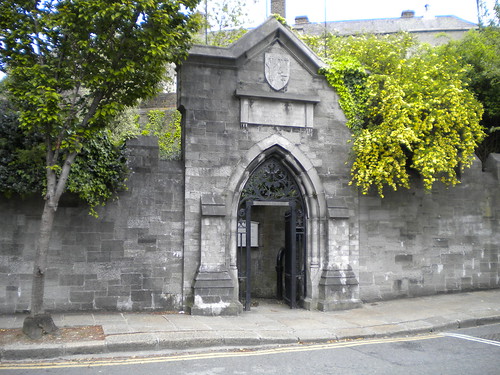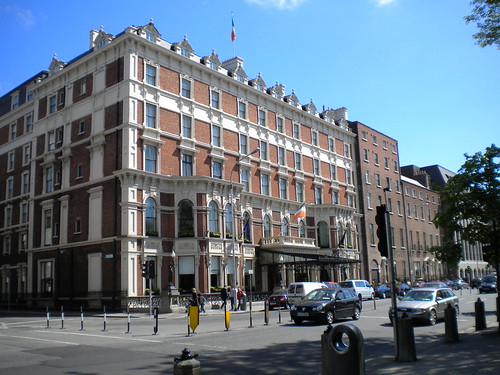
A Ghost Watcher's Guide to Dublin
By Meagan Stroud
The stories below are adapted from A Ghost Watchers Guide to Ireland by John Dunne.
No. 7 Hendrick Street
Numerous ghosts have been reported at No. 7 Hendrick Street before it was demolished in the 1960s. The most reoccurring tale is the sound of bare footsteps running down the stairs from the upstairs flat into the main hall, accompanied by a burst of cold air. Poltergeist actions had also been observed, such as a steel-handled knife flying off the dresser and then back to its original position. In addition, the caretaker of the house died in the early 1920s, and several times during the following months, residents saw and heard her working in the backyard at night.
The Ghost of Marsh’s Library

Marsh’s Library was founded by Archbishop Narcissus Marsh in 1707. Therefore, it is only fitting that his ghost should haunt it, especially as it was a place close to his heart.
The figure of the Archbishop has been seen searching through old volumes in the inner gallery of the library that was his own during his lifetime. Legend has it that he is looking for a letter from a beloved niece that he raised from a child. She fell in love with a sea captain, and as her uncle did not approve of the match, the couple eloped. The niece left a note asking for forgiveness in one of his books, which he never found during his lifetime.
The Headless Rider
A formidable headless rider on a white horse has been seen multiple times riding down Jones’ Road in northern Dublin in the dead of the night. The rider is rumored to be the ghost of the namesake of the road, Buck Jones, a city sheriff and gambler. Jones was more prone to act upon his gambling habits than his official duties and was thrown into Marshalsea Barracks where he later died, not far from his beloved home and Jones’ Road.
The Dean’s Ghost

One of the more well-known spirits that still haunts Ireland is the ghost of Jonathan Swift, the author of "Gulliver’s Travels." Although numerous places are rumored to be haunted by the late author, the most common is St. Patrick’s University Hospital, a psychiatric institution Swift founded in 1745. It was the first mental hospital in Ireland, one of the first in the world, and Swift left his entire estate (including royalties) to the hospital. The hospital opened its doors the same year that the author died, and ever since, both staff and patients alike have testified to evidence of his ghost.
Vengeance of Olocher

Black Dog Prison was prison in “Hell,” a section of old Dublin that is now referred to as Cornmarket. The most infamous tale of Black Dog is that of Olocher, a murderer who escaped the gallows by committing suicide.
This dramatic suicide alone would have been enough to frighten the people of Dublin, but Olocher’s spirit personified as a large black pig that attacked women in the night terrified them. The night after the suicide, one sentry was mauled by a large black pig, and another went missing, leaving his clothes and gun behind. It was assumed that the pig had eaten him. Several women were also attacked by the pig on following nights, and most of the reports were verified as genuine. The attacks continued throughout the winter and became generally accepted that it was the ghost of Olocher, referred to as “Dolocher,” seeking vengeance on the people of Dublin.
The Ghost of Roper’s Rest
Roper’s Rest, off Blackpitts Road, was the home of Thomas Roper who became Viscount Baltinglass. After nightfall, local residents have seen a headless horseman riding by, causing them to hasten to their homes in fear. Although no specific connection has been established between Roper’s Rest and the horseman, it is rumored to be associated with a gruesome incident in which a member of the Roper family died and was unattended to for several days before burial.
The Cross of Holy Week

Iveagh House, which is now the home of the Department of Foreign Affairs, is the site of one of the most religious stories of paranormal activity in Dublin. Every Holy Thursday, a cross is said to appear in a pane of glass of one of the windows on the house. The most popular story for this occurrence is that a Catholic servant in the Protestant household had lain dying in the room and had been refused a priest. Her employer had caught her praying the rosary and had thrown the beads out the window, breaking the pane in his fury. Others believe that the cross is related to the death of the Archbishop of Cashel, who was murdered in 1583 on the location where the house was later built.
The Tallaght Ghost
Many a lonely road is said to be haunted by a coach driven by a headless driver, a sure omen of imminent death. Tallaght, just outside of Dublin, has its own phantom coach which careens wildly through the roads along the base of the Dublin mountains. Drawn by six headless horses, it carries the ghost of Archdeacon Bulkeley, a wealthy landowner who lived in Oldbawn House in the city.
The Shelbourne Hotel

One of the most famous hotels in Dublin is the Shelbourne Hotel, located in St. Stephen’s Green. In the 1960s, an American investigator, Hans Holzer, stayed at the Shelbourne while conducting research for his book The Lively Ghosts of Ireland. To assist him in his research, he was accompanied by a medium, who stayed in a small room on the top floor of the hotel during their visit. The medium claimed the room was haunted by a small girl, Mary Masters, who spoke to her. There is no record of Mary Masters to support this, but it is possible that the girl has fallen through the cracks in the long history of the Shelbourne or that she died in one of the four houses on the property before the hotel was built.
The Black Dog of Cabra
On the north side of Dublin is a small suburb called Cabra, where an old house was demolished in the 1930s. During its existence it was shunned by its neighbors, due to the presence of a large phantom black dog on the estate. The dog was said to be the ghost of the only owner of the house, the notorious “hanging judge” Lord Norbury. Norbury was most famous for presiding over the trial of Robert Emmet and the other participants in the 1798 rebellion.
The Beresford Story

Tyrone House, now part of the Department of Education, was the former location of a painting of Lady Beresford with a black ribbon tied around her wrist. The ribbon is a symbol of the story of a pact between Lady Beresford and Lord Tyrone.
The two nobles had made a pact that whichever of them died first would come back from the grave and visit the other to prove that there was an afterlife. Tyrone died first and came to her in her bedroom at night to fulfill the pact, touching her wrist to prove that he was real. To her horror, Lady Beresford discovered that this portion of her wrist had withered at the touch. To obscure it from view, she covered the spot with a black ribbon for the rest of her life. There is no existing record of this famous painting, but Sir Shane Leslie, the late Irish diplomat and writer, claimed that he had seen the ribbon itself, kept as a family heirloom.
The Summerhill Ghost
Oftentimes a ghost will not appear until its lodgings are about to be torn down. This is true of the ghost of 118 Summerhill.
In January 1966, No. 188 Summerhill, an old tenement house, was scheduled to be demolished. Within a few days, demolition was called to a screeching halt after three workmen had seen a ghost in a striped apron (similar to that of a butcher’s) on several occasions during their work. Although there were no previous reports of paranormal activity in the house, historical records verify that a man named Patrick Conway, a butcher, slit his throat on the premises in 1863.